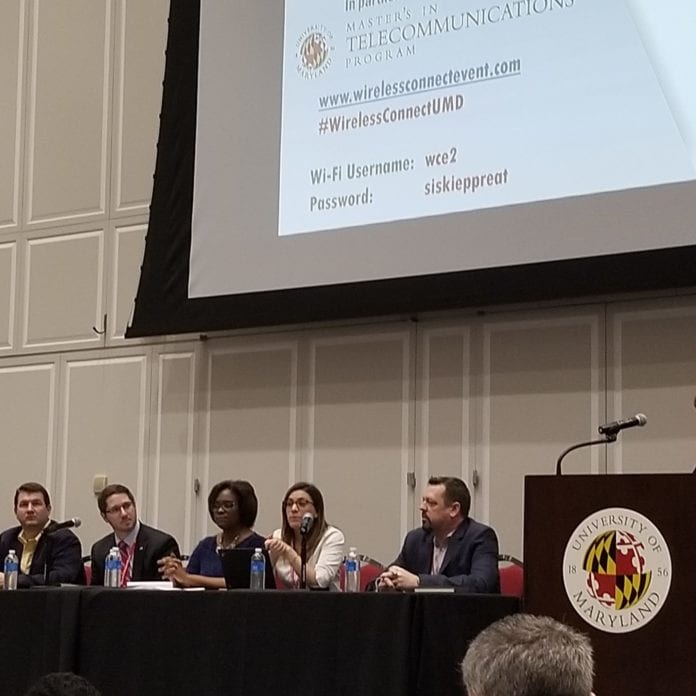COLLEGE PARK, Md.–The telecom and tech industry tends to focus on the positive aspects of smart cities — but panelists at the recent Wireless Connect event grappled not only with the potential good of smart cities but the unintended consequences.
Some of the interest in smart city technologies is driven, at least in part, by a fear of missing out on the good that such initiatives can bring.
“We want smart cities because we don’t want dumb cities,” said Nicol Turner-Lee, a fellow at the Brookings Institute’s Center for Technology Innovation. Smart city initiatives are often aimed at improving quality of life and citizen engagement, she said, pointing to examples such as Boston’s experimentation with apps to crowdsource pothole discovery; and Sacramento, Calif., where a 10-year public-private partnership with Verizon is providing digital kiosks and free Wi-Fi so that citizens can conduct business with the city outside of brick-and-mortar government buildings, along with allowing the carrier to put in small cells and eventually upgrade to 5G infrastructure.
Ryan Elm, founder of IT consulting and research company Integrity Tech, compared the current conversations around smart cities to those around cloud computing technologies in the 2006 to 2007 timeframe: cities are still grappling with exactly what it means to be a smart city. He also compared the scaling of smart cities to the evolution of the smartphone, in that it may take a decade or more for people to truly learn how to manage them.
Joe Kochan, co-founder and COO of U.S. Ignite, said that often when presented with a new resource such as a fiber network, cities aim to make municipal services “better, faster, cheaper, more efficient and reach more people.”
Kochan said that one of the difficulties of smart city technologies is that often, lab-scale technologies don’t work beyond the lab and large-scale testbeds are often proprietary or otherwise closed to cities. US Ignite this week announced two winners of millions of dollars in funding from the National Science Foundation and a consortium of telecom companies, to develop smart city testbeds that can be used by academics, corporations and cities themselves to try out new technologies — not just underlying technologies such as 5G New Radio, new antenna types and mounting techniques, he said, but “see what happens when you put some of these applications in the wild, when you go from 100 street lights to 100,000 street lights … the collateral damage, or the good things that can happen.” The winners of the first funding round were New York City and Salt Lake City.
Turner-Lee also brought up the impact of data science and smart city analytics, and the need to be careful that algorithms which parse the collected data are actually doing what they are supposed to do and not passing along human biases. She noted that New York City recently passed a bill to create a task force to advise city agencies on addressing the potential harm from discriminatory algorithms. Technologies are vulnerable and data can “create hiccups” where underserved communities are left out or unfairly targeted.
Kochan said that while 5G is still vague and emerging, it’s clear that cities will need more cell sites, higher capacity, lower latency, and more security to achieve their “smart” visions. In spite of the much higher network equipment density that will be needed for 5G, he was confident that compromises will be made in order to get infrastructure in place to deliver services that people want. What he sees as the thornier issue, though, are the unintended consequences of the large-scale, comprehensive intelligence platforms that cities and the industry envision.
He pointed out the ongoing controversy at Facebook, where the unintended consequences of an open social media platform with global reach has been that it can be co-opted, and now the company is struggling to deal with situations that it never anticipated. Kochan said it will likely take years to unwind all of the unintended consequences just for that platform, and cities are starting to grapple with the reality that — while they fear of missing out on the benefits of smart cities — there are also risks to becoming a smart city, not all of which are known at this point.
Elm said that no single person will solve the issues around smart cities, and that it will take leaders within local communities and possibly be driven by educational institutions, both in K-12 and higher education. Younger generations, he noted, are less likely to have privacy concerns about the terms under which they use services, and application and device design is far more intuitive than it used to be — but, he added, a significant percentage of the population is still not online, often people who are in rural areas or who are poor, disabled or in minority-majority communities that cities will have to figure out how to engage. But as more people and devices become connected, he said, connectivity itself becomes more like a utility or public good that people want others to have so that their own services function more seamlessly — at some point, no one will want to be the person with the non-autonomous vehicle.

